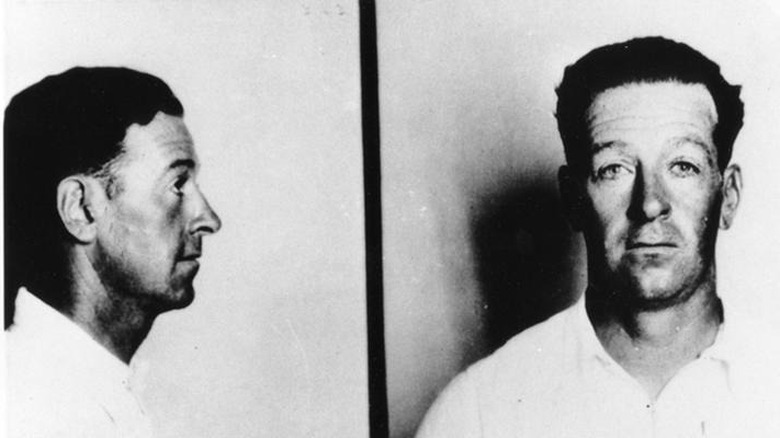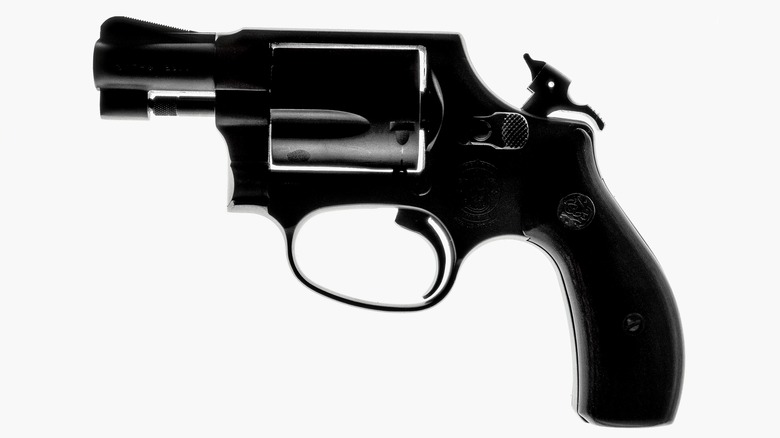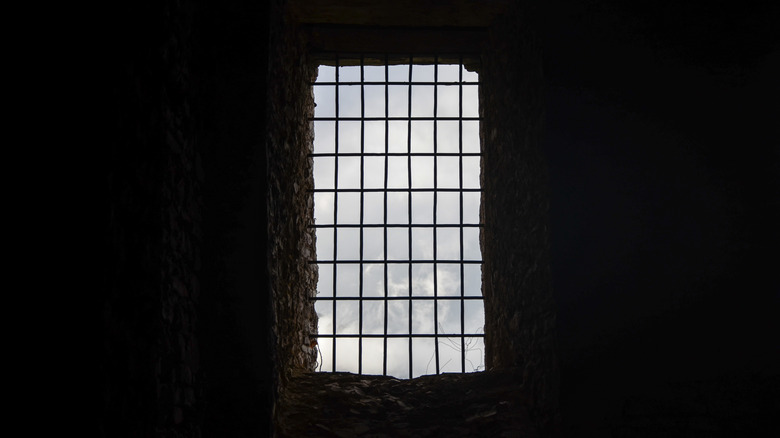The Truth About The First Person On The FBI's Most Wanted List
Ominous and daunting connotations string from the mere mention of the "FBI's Most Wanted List." On their official website, the FBI denotes the criteria of a "most wanted" candidate as an "individual [who] must have a lengthy record of committing serious crimes and/or be considered a particularly dangerous menace to society due to current criminal charges." Ted Bundy, Osama Bin Ladin, and 524 other agents of notoriety have appeared on the Bureau's dark roster over the past 70 years. Of those targeted, 491 have been caught.
The Most Wanted List was founded by then FBI director J. Edgar Hoover in 1950. The conglomeration of names was inspired by a reporter's inquiry requesting descriptions of the "toughest guys" the government was out to get. Hoover prospectively sought to prioritize pursuit efforts while simultaneously inviting public cooperation and assistance into the equation, and since then, 163 criminals have been brought to justice with the help of everyday citizens and information they've provided authorities with. The first name to ever appear on the Most Wanted List — then called the FBI's "Ten Most Wanted Fugitives" — was Thomas James Holden. Holden was singled out by police and government officials after he murdered his wife and her two brothers (via FBI).
Who was Thomas James Holden?
Prior to becoming a nationwide fugitive, Thomas James Holden was a reputed crook who robbed trains alongside his friend and criminal associate Francis Keating. Together, the thieves were known as the Holden-Keating Gang. The two terrorized the Midwest throughout the 1930s via a slew of armed robberies and murders that ultimately led to Holden's arrest and a subsequent stint behind bars that ended in 1947 (per History Daily).
He was only discharged after severe heart complications prompted authorities to remove him from Alcatraz and send him home (per Oregon Live). However, it wasn't his first experience as an inmate. Following a conviction that connected him to robbing trains in the 1920s, Thomas James Holden was sent to Leavenworth federal prison and actually managed to escape from the institution after a time. His subversive and deceptive tendencies seemed inherent in his persona, and the decision to prematurely release him back into the world would tragically result in the taking of three innocent lives. One particular news outlet would later label him as "a product of the mad-dog days of gangsterism" and a "man whose freedom in society is a menace to every man, woman and child in America" (via Oregon Live).
Earlier arrest and escape from Leavenworth
It was in 1928 that Thomas James Holden and his criminal compatriot Francis Keating were first sent to prison following a train robbery in Evergreen Park, Illinois. They were sentenced to 25 years at Leavenworth prison for their crimes, but after serving only two, Holden and Keating managed to escape using counterfeited credentials and fled to Minnesota to start a new life of crime. In what almost seemed like a gesture of mockery, they began a system of smuggling contraband (firearms and bullets) into Leavenworth in an effort to help their former prison mates break free and were officially immersed in a new conquest of criminality (via Mental Floss).
Train robberies became a regular practice again for the freshly rejuvenated Holden-Keating Gang and their new team of cronies. However, their impetuous malfeasance ultimately caught up with them and police apprehended the fugitives in 1931 along with two other escaped inmates. The four men, who were discovered by authorities swinging clubs on a Kansas golf course, readily surrendered and were returned to prison, this time under a more watchful eye. The legendary Alcatraz prison in San Francisco, California became Thomas James Holden's new home for the next 16 years. Al Capone was also carrying out his sentence at Alcatraz throughout that time (per Mental Floss).
In cold blood
Starting on November 28, 1947 – the day of his release from Alcatraz prison, Thomas James Holden was placed on parole and returned home to Chicago, Illinois with his wife Lillian. For two years, Holden's life remained free of crime or significant infraction, and it seemed as though peace and civility had finally settled into his troubled, insubordinate nature. Sadly, the period of civility would soon come to a bitter end through a senseless act of barbarism and compulsive cruelty (via Mental Floss).
The grisly scene was discovered by police after they responded to a frantic phone call on June 5, 1949, from one of Holden's neighbors. Cops found three dead bodies — Lillian and her two brothers had all been shot to death with a .38 caliber pistol (per Oregon Live). Elva Griffin — wife of deceased Ray Griffin — Lillian's brother — had also been shot in the cheek and survived the assault. She explained to officers that the group had been out drinking throughout the night, and upon returning home, an argument took place between Thomas and Lillian that elevated into a screaming match. When Ray Griffin and John Archer (Lillian's half-brother or step-brother depending on the source) tried to restrain Holden after he started beating his wife, Holden seized a pistol and killed all three on the spot before turning the gun on Elva. He subsequently fled and a manhunt promptly ensued (via Mental Floss).
Thomas James Holden on the run
It wasn't until 1950 when J. Edgar Hoover officially introduced the "Ten Most Wanted Fugitives" that Thomas James Holden's pursuit by police would assume a whole new level. At that point, he'd already been on the run for close to a year, so efforts to apprehend him and bring him to justice were still feverishly ongoing. A national newspaper published the list along with descriptions and photographs of the fugitives at large, and at the very top, Holden's face stared back at readers menacingly.
The American public thence became woven into the fold of criminal pursuit alongside the federal government. It was in 1951 that a local resident in the town of Beaverington, Oregon recognized Thomas James Holden's face in The Oregonian (a statewide newspaper). The civilian immediately contacted authorities who shortly thereafter descended upon Holden at his place of work. He was living in the small town under the alias John Roger McCullough and working as a plasterer under the employment of one Charles Robinson. After resisting confession and sticking to his false identity for as long as he could, Holden ultimately admitted to the murders and was shipped back to Illinois to await trial (via Oregon Live).
Prison sentence and death
Charles Robinson, Holden's former employer, described his ex-employee as one of the best workmen on his team. His coworkers even made jokes about the disturbing similarities between their friend John Roger McCullough and the notorious face on newspaper stands. Additionally, Holden's landlady shared with The Oregonian after his arrest, "He was a model tenant. I suspect a lot of people about being crooks, but not this one. I'm a little shocked. I took his rent every week. He always was happy and singing Irish folk songs. He had a good enough voice to be in opera" (via Offbeat Oregon).
In November of 1951, Thomas James Holden stood before judge and jury and was convicted of murdering Lillian Holden, Ray Griffin, and John Archer in cold blood. Eva Griffin, whose testimony provided a death blow to Holden's defense team, appeared before the court and shared her harrowing story. Following conviction, he was sent to Illinois State Prison to carry out a life sentence. However, after only two years, Thomas James Holden died at the age of 57 of a heart condition. (per History Daily).





